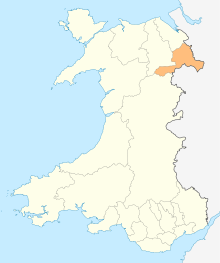Rhosddu
Rhosddu (![]()
Administrative history
The name Rhosddu is formed on the Welsh words rhos, "moor" or "rush pasture", and ddu, "black". It was formed as a new ecclesiastical parish by an Order in Council in 1886. The parish contained the townships of Acton, Bieston and Gourton (from the parish of Wrexham), the township of Borras Riffri (from the parish of Gresford), and the township of Stansty (from the parish of Gwersyllt).[2] In 1972, Rhosddu reverted to the parish of Wrexham.
The area of Rhosddu was in the civil parish of Stansty, which was part of the old Wrexham Municipal Borough. The administrative structures of the Municipal Borough were abolished in 1974, under the terms of the Local Government Act 1972. Rhosddu was created as one of the communities of Wrexham Maelor after a 1985 boundary review, which brought four new 'town' communities into being within the town of Wrexham itself (Rhosddu, Offa, Caia Park, and Acton).
Dissenters' Burying Ground
The Dissenters' Burying Ground on Rhosddu Road was originally a field of about one acre and is believed to have come into the possession of the Wrexham Nonconformists during the early 1600s. In 1788, an ongoing ownership dispute of the Ground was resolved allowing Presbyterians to be buried there upon payment of a fee to the Baptist Church. Hay was grown and sold to pay for a grave digger and other expenses.[3] Many notable people are buried here including the great mystic, Morgan Llwyd, who died in 1659. When the Ground was closed in 1888, it contained 27 family vaults, a number of brick graves and 920 private family earthen graves.[4] Unfortunately, during the night of the Wrexham races, in the mid-1840s, all but one of the brass memorial plates were stolen from the tombs, thus destroying many family histories.[5]
St. James's church
photographed in May 2013
The foundation stone of the new church, dedicated to St. James and built in Cefn sandstone to designs by W. Turner of Wrexham, was laid on 30 September 1874. It was opened for worship in January 1876, although it was not consecrated until 27 April 1886. The church is now a Grade II Listed building, being considered a good example of a late 19th-century church retaining many original features.[6]
Residents
John Godfrey Parry-Thomas, the engineer and motor-racing driver, was the son of the curate of Rhosddu and lived in the area during his childhood.
Sports
Wrexham A.F.C. played their home games in the 1881–82 and 1882–83 seasons at Rhosddu Recreation Ground (changing the club's name to Wrexham Athletic for one season), before moving back to the Racecourse Ground for the 1883–84 season, where they have remained.
References
| Wikimedia Commons has media related to Rhosddu. |
- "Community population 2011". Retrieved 19 November 2015.
- Rhosddu, St James, GENUKI
- Palmer, A.N. 1888, A History of the Older Nonconformity of Wrexham and its Neighbourhood, Wrexham: Woodall Mishall and Thomas.
- Price, G. V. 1951, The dissenters burial ground, Wrexham
- Palmer 1888,p.164
- Church of St James, Rhosddu, Wrexham Archived 2012-03-21 at the Wayback Machine, Wrexham County Borough Council
